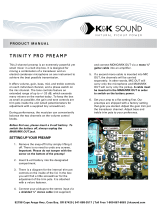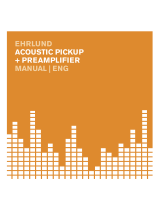
12
phantom power with your R92 as a general rule. It is recommended to
make a habit of disengaging phantom power a minute or two before
plugging in your R92.
Wind Gusts
A second and equally important rule is never blow directly into any
microphone to test it. Not only does this force moisture and dirt into
the microphone, strong air movement also can stretch the ribbon and
while it may not break, it nonetheless could significantly degrade the
microphone’s performance. The ribbon in the R92 is protected by multi-
layered screens and grille cloths to provide superior wind protection.
Nonetheless, using it outdoors requires special care to avoid wind
which can damage the ribbon. Indoors, however, it is also important to
avoid serious air movement from stage curtains, open windows, doors,
or air-conditioning systems. High SPL sound sources do not usually
pose a problem because AEA ribbon microphones can handle 165 dB
SPL or more without difficulty. It is only those “explosive” sources that
produce a strong blast of air, such as the bass port on an electric guitar
or bass amp, a guitar being plugged (or unplugged) while the amp level
is turned fully up, an on-axis kick-drum (particularly with a port on the
front head), that are potentially damaging. If you are unsure about how
much wind is hitting the microphone, place the back of your hand where
the microphone is going to be. If you can feel significant wind blasts,
angle the microphone or use a pop screen to avoid direct hits.
Tramp Iron
Minute iron particles, sometimes known as “tramp iron,” are common
within our environment. AEA ribbon microphones contain powerful
magnets that produce strong magnetic fields. These fields can attract
any ferric metal near the microphone that, if they are small enough, can
penetrate the outer screening and work their way inside the microphone.
Over time, this “tramp iron” can build up sufficiently in the magnetic gap
to rub against the ribbon causing distortion, electrical shorts or tearing
of the ribbon. The best prevention is to keep the microphone covered
with the supplied plastic bag when it is not in use.
The R92 was designed to be less sensitive to external interference. It’s
design attract less “tramp iron” while retaining the overall sound and 20
Hz bass response of the original RCA 44.
Under no circumstances should you disassemble and take the grille off




















